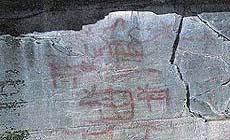|
|
 |
 |
Country: |
Sweden |
Locality: |
Flatruet |
|
 |
Region: |
Härjedalen |
Area: |
Tännäs |
|
 |
 |
|
|
|
|
| |
 |
Environment & Surface |
 |
 |
 |
|
Open-air
Shelter
Cave
Portable
Megalithic
|
Geography: |
Mountain plateau just at the three-limit. |
Proximity: |
Vast view over woodland and mountains. |
|
 |
Geology: |
Fine-grained, greyish rock. |
Surface: |
Vertical rock surface, cracks and microflora. |
|
|
|
|
 |
 |
|
|
|
|
| |
 |
Art |
 |
 |
 |
Description: |
Engravings
Paintings
Painted engravings
High or low-relief
Sculpture
Flatruet, Tännäs parish, Härjedalen. The painting at Flatruet consists of c. 20 animal figures. Mostly elks but at least one reindeer and one bear are represented. Furthermore, there are 5 stylised human figures with raised arms, adorating position, and there are also a number of strokes/lines and some paintstains.
|
Figures: |
total number 20
Animal figures/elks/reindeer/bear
Human figures
Strokes/lines
Stains
|
|
 |
Chronology: |
Palaeolithic
Epipalaeolithic - Mesolithic
Neolithic
Copper Age
Bronze Age
Iron Age
Roman
Middle Age
Modern
Unknown
The Flatruet painting is relatively dated to c. 2000 BC, based on comparisons with similar figures in Northern Sweden and Norway.
|
Notes: |
The Flatruet rock painting is situated at a mountain plateau with a vast view over the surrounding woodland and mountain tops. Close to the site, there are a possible dwelling site of the mobile hunting- and trapping culture, based on the intricate waterways and extensive forests and mountains surrounding them in Northern Sweden (Jensen 1989:236). |
|
 |
 |
|
| |
 |
Bibliography |
 |
|
|
|
|
| |
 |
Conservation |
 |
 |
 |
Status: |
Public
Private
Park
Classified site
|
Risk: |
The paintings are generally faded and faint, and the natural and chemical weathering does not make it better. |
|
 |
Conservation: |
Good
Quite good
Mediocre
Bad
|
Intervention: |
Concerning the fact that the paintings have been carried out on almost vertical rocks, often with a projecting rock which protects the painting, might explain why so many rock paintings still are conserved up to this date. Also the chemical constitution of the ochre colour are an important fact. Some rock paintings are filled in. |
|
 |
 |
|
|
 |
By |
 |
|
| |
| Record n. 798 / 807 |
No commercial use is allowed. Specific © is mentioned in the captions or owned by each Author or Institution |
|
| |
 |
EuroPreArt, European Prehistoric Art, is a web-based archaeological project funded by the European Union which aims to establish a lasting data-base of European prehistoric art documentation, to launch the base of an European institutional network and to contribute to the awareness of the diversity and richness of European Prehistoric Art.
It is proposed by: Instituto Politécnico de Tomar (IPT, Portugal),
CUEBC - European University Centre for Cultural Heritage (Italy - Europe),
Consejo Superior de Investigaciones Científicas (España),
Asociación Cultural Colectivo Barbaón (España),
Université de Liège (Belgique),
Gotland University College (Sverige),
University College Dublin (Eire),
Cooperativa Archeologica Le Orme dell'Uomo (Italia),
Study Centre and Museum of Prehistoric Art of
Pinerolo (Italia),
The European Centre for Prehistoric Research in the Alto Ribatejo (Portugal),
ArqueoJovem - a youth NGO (Portugal).
|
|
|
|
 |
|
 NEW: Alpine rock paintings
NEW: Alpine rock paintings
